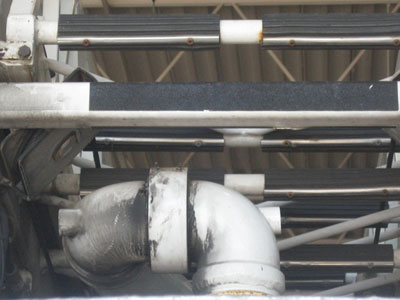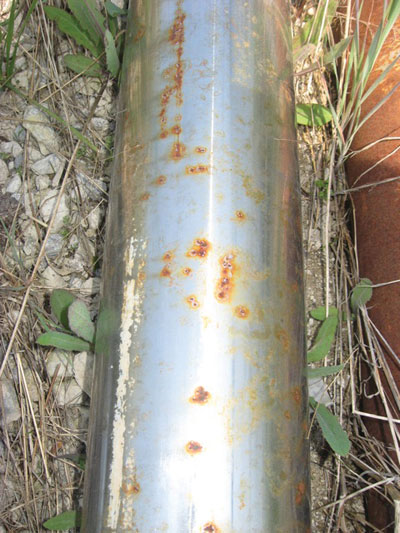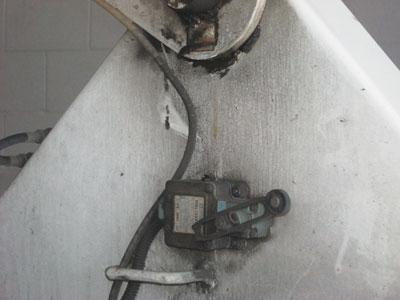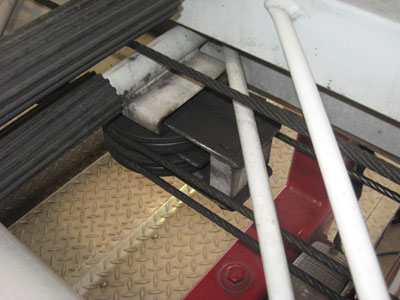
Equipment
Truck Tech: June 2012
My last column discussed aerial preventive maintenance at the station level.
June 11, 2012
By Chris Dennis
My last column discussed aerial preventive maintenance at the station level. Making sure firefighters are trained on this piece of apparatus is your department’s first line of defence. The truck checks that firefighters perform are based on department SOPs and manufacturers’ suggested standards of operation. These checks – and the discovery of any problems with the apparatus – will give the station officer a clear understanding of what’s wrong.
So, part 2 goes like this: we are addressing a 17-metre, or 55-foot, steel aerial quint. It is the end of a hard winter – well, not here in Ontario, but we will pretend it was. The inspection has been performed at the fire-station level and you have been advised: the ladder is filthy, multiple lights are not working and the hydraulics are sluggish.
When an apparatus defect is discovered, it is the fire department’s responsibility to provide guidance for the firefighter about what needs to be done, depending on the severity of the deficiency. NFPA 1911 identifies out-of-service criteria for the following areas:
- Driving and crew
- Apparatus body and compartments
- Chassis, axles, steering and suspension systems, driveline, wheels and tires
- Engine systems
- Engine cooling system
- Transmission and clutch
- Low-voltage and line voltage electrical systems
- Braking systems
- Air brake systems
- Hydraulic brake systems
- Fire pump system
- Aerial device system
The standard provides excellent guidance about when to take the apparatus or an identified component out of service and when you should call a qualified technician to evaluate the component.
 |
|
| Throughout the year, road grime can build up on the aerial, especially in rural communities, where dirt roads are common. | |
 |
|
| When the waterway sits in water, it is sandblasted with sediment, resulting in pits and rust. | |
 |
|
| Use a soft brush to degrease all painted surfaces and chrome, taking special care around switches and other electrical components. | |
 |
|
| Avoid the use of high-pressure water on the cables. These parts trap water, slowly causing the cables to deteriorate from the inside out. Photos by Chris Dennis |
If this information comes to you in written form through your chain of command, note that some detail may be lost in the description of an issue – a phone call or face-to-face discussion may be best. With 24-hour shifts and multiple shift rotations, it is not always easy to speak directly with the operator of the equipment – whether you have a mechanical division or not. If possible, speak directly with the trained operator to discern exactly what issues have arisen. Get as much detail as possible to pinpoint the concerns.
Vaughan Fire and Rescue Service is fully equipped with a multi-bay repair facility and four trained EVTs. When an issue arises, the information is passed through a chain of command to the apparatus division or the on-call technician. The technician’s job is to get the information and translate it into terms that the on-duty senior officer can understand. In the case of our quint, it had been determined that this particular apparatus would come out of service.
Once the unit arrives at VFRS, the defects are recorded and the repairs are made. Then comes maintenance. One of the concerns was the filthy aerial. Road grime in the winter can make the aerial dirty. Dirt, over time, can result in costly repairs, and this apparatus was not built to come out only on nice days.
Washing the aerial is the first point of business, and spring is the best time to do this. Find a secure area and set up the truck. Fully extend the aerial to its lowest point, in this case, off the back. Set up pylons around the extended unit so that it does not get hit by another vehicle. With the aerial fully extended, use a biodegradable degrease on every part of the ladder, including the cables, sheaves, rungs, hydraulics, pins, and control levers. Let the degreaser soak in. Wearing safety glasses, gloves and some clothing you don’t mind getting dirty, use a soft brush to scrub the degreaser onto all painted surfaces and chrome. Use caution around switches and electrical components, and do not scrub cables too hard – just enough to remove the grime.
Once this is complete, a power washer or a garden hose with an attachment can be used to wash off the degreaser. Do not push high-pressure water into the cables – the cables will trap the water and will slowly deteriorate. Follow the manufacturer’s guidelines for cleaning and re-lubing the aerial. Let the unit dry completely.
You can use mild soap and water to clean aluminum ladders. With a steel ladder, we use an EP2 food-grade white grease. We brush all the slide areas as set out by the builder. A slight film of transmission fluid on a rag is wiped over the cables. Caution: The cables have fine barbs, so be careful not to get a metal sliver or cut. The same transmission fluid can be used to wipe off chrome cylinders and waterways. Most grease schematics can be found with the as-built manual, providing the correct locations, type of grease, and recommended amount to use.
So, the dirty part is done. Run the aerial through all its paces to be sure it moves smoothly and correctly. A chatter or shudder after all this work usually means something is not lubricated. Recheck your work, re-lubricate any dry areas, and if all that fails, find a qualified EVT to readjust the cables. If compressed air is available, blow off all the electrical connections and switches and make sure all proximity switches are free of dirt and greasy film.
Re-check all functions of the stick, including the electrical operations.
This truck is a quint, so it has a waterway. With the ladder fully extended, inspect the chrome water tube for rust and pitting. If pitting and rusting is evident, note its location and advise the maintenance crew. Pitting is usually found on the lowest part of the tube, or the part facing the ground, indicating that the waterway has not been completely drained after use. If the water you are pumping is from a pressurized source or a static source, it is imperative that the stick be raised (observing all overhead obstructions) and completely drained after use. Both treated and untreated water contain hard sediment, which will sit and thicken in the lowest part of the tube if it is not allowed to drain. The clearance between the waterway tube and the outer painted tube is extremely tight inside. As you drive down the road, the chrome waterway bounces slightly inside the outer, painted housing tube.
This shakes up the sediment, which acts like a sand blaster and easily damages the chrome. So, sitting in water that is being sandblasted internally makes pits, and then causes rust. If you extend the waterway, the rusty pits will go by, causing small cuts every time the waterway moves past the rusted spots, resulting in water leaks. Draining the waterway completely helps to prevent this.
The waterway on our aerial is pitted and not leaking, but we needed a new one, and the item was back-ordered five days. A little trick to help slow the damage being caused to the packing and wiper: use 000 steel wool and good penetrant. Apply the penetrant to the chrome tube and let sit for a few minutes, as you would a rusting nut and bolt. Then, lightly rub the 000 steel wool up and down the contaminated area. This will knock off the high spots and drive the penetrant into the pits to slow the rusting. Once this is complete, wipe away the water with transmission fluid. Leaving a slight film on the chrome tube, retract and extend the tube a couple of times. Be sure no water is left to sit in the tube. If there is sediment, flow some water through the waterway to help break it up and then drain the water way completely. If it is bad, you will see the color of the water change as it gets cleaner.
Now that a complete cleaning has been done and all lubrication points have been addressed, we can check the other defects reported.
The hydraulic seems sluggish: well, the bath we just gave the aerial fixed that. The dirt was binding up the system. Be sure, though, that the hydraulic oil level is correct and the hydraulic filter is clean. Run the device through all its paces, verifying that all interlocks, safeties, and lights are working.
We will now touch on stabilization. The controls must be arranged so that the operator can view the stabilization movement. An indicator will denote when the apparatus is operable within the manufacturer’s range of level conditions. Stabilizers that protrude beyond the body will have one or more red warning lights and be striped or painted with reflective material.
Be sure all hydraulic control levers operate smoothly and return to a neutral position, and that there is no hydraulic function when controls are in their neutral position. These areas get dirty and can be degreased and lubricated. Check all these conditions and pieces for correct function. All this is in NFPA 1901 1911.
Some time requirements must also be met, as per 1901 1911. With stabilizers set, the aerial ladder should be capable of being raised from the bedded position to maximum elevation and extension and rotated 90 degrees.
- 110 feet (34 metres) or less in 120 seconds
- Vertical height over 110 feet (34 metres) in 180 seconds
- Elevated platform of 110 feet (34 metres) or less in 150 seconds
- Stabilizers in stored position to operating position within 90 seconds.
Inspections are required every year but nondestructive tests of the welds and other parts are required only every five years. Some testers believe it’s best to simply do the nondestructive tests, which are thorough and don’t take much more time than an annual inspection, but there is a cost involved in contracting a third party to do the tests.
If you ever raise your aerial, these tests are a must for safety. Few departments have the facilities, equipment, and certified personnel to do these tests and even those of us who have the know-how contract a third party who specializes in this testing.
Now that all this is done, the aerial has met all its standards and there are no other defects, do yourself a favour and check all levels, lights, brake adjustment and be sure the air conditioning is working. If all this is OK, put this rig back in service.
(A special thank-you to Capt. Peter Ross of Toronto Fire Services, mechanical division, for all the work he has done on the F5 Aerial Fire Apparatus component of the EVT exams.)
Remember, my friends: rubber side down.
Chris Dennis is the chief mechanical officer for Vaughan Fire & Rescue Services in Ontario. He can be reached at Chris.Dennis@vaughan.ca
Print this page